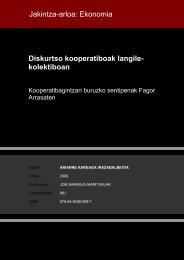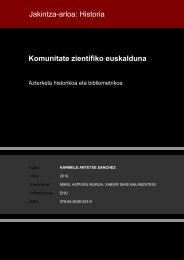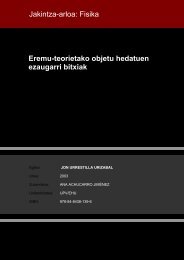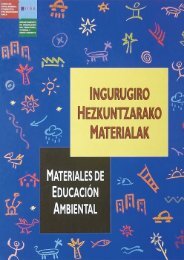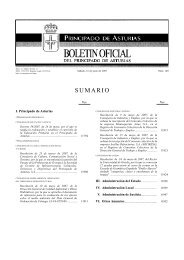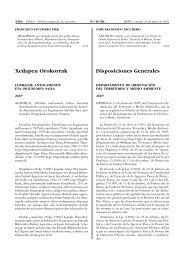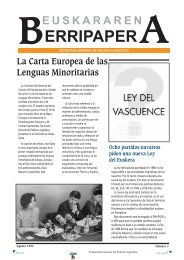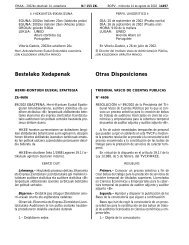MOLUSKUEN LISERI-GURUINEKO EPITELIOAREN ... - Euskara
MOLUSKUEN LISERI-GURUINEKO EPITELIOAREN ... - Euskara
MOLUSKUEN LISERI-GURUINEKO EPITELIOAREN ... - Euskara
You also want an ePaper? Increase the reach of your titles
YUMPU automatically turns print PDFs into web optimized ePapers that Google loves.
Emaitzak eta eztabaida<br />
Digestive cell turnover in the digestive gland epithelium of slugs<br />
experimentally exposed to a mixture of cadmium and kerosene<br />
Abstract: Slugs, Arion ater (L), have been proposed as sentinel organisms to assess soil environmental<br />
health. In slugs under the influence of pollutants changes in the cell-type composition of the digestive-gland<br />
have been observed, among these changes, the most remarkable one is the loss of digestive cells and the<br />
related increase of excretory and calcium cells.The aim of the present work was to determine whether<br />
digestive cell loss affects biomarkers of exposure and effect and whether is reversible in the digestive gland<br />
of slugs exposed to a mixture or metal and organic pollutants under laboratory conditions. For these<br />
purposes, slugs collected from a non-polluted site (Delika, Basque Country) were dosed with 10 µg Cd/gr<br />
+ 30% of the water accommodated fraction of kerosene in the food for 27 days. Metal body burdens and<br />
kerosene tissue levels were measured. The volume density of black silver deposits (Vv BSD ) revealed by<br />
autometallography, and the activity of the enzyme acyl-CoA oxidase (AOX) were used as exposure<br />
biomarkers. As effect biomarkes, changes in the volume density of the three cell types that constitute the<br />
digestive gland epithelium in slugs (digestive, excretory and calcium cells) were calculated. Proliferating<br />
cells were identified by means of bromodeoxyuridine (BrdU) immunohistochemistry. The results of the<br />
present work revealed that the mixture of pollutants provoked an increase in Vv BSD and AOX activity as<br />
well as a decrease in the number of digestive cells. Anyway, these changes had no effect in the capacity of<br />
the digestive gland to accumulate or in the effect and exposure biomarkers employed. Moreover, the<br />
change in cell-type composition measured in the digestive epithelium was reversible after 7 days of<br />
detoxification. BrdU-labelling showed that exposure to pollutants provoked an enhanced digestive cell<br />
proliferation, that perdured during detoxification<br />
Key words: digestive gland, slugs, cell-type replacement, cadmium, kerosene, effect and exposure<br />
biomarkers.<br />
164



